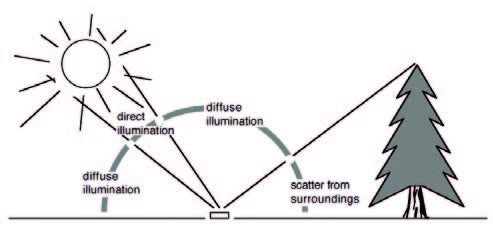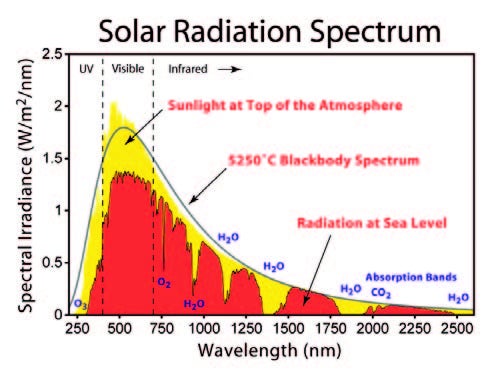
Figure 1. Sources of Illumination (ASD Inc., n.d.)

Figure 2. “This figure shows the solar radiation spectrum for direct light at both the top of the Earth’s atmosphere and at sea level. The sun produces light with a distribution similar to what would be expected from a 5525 K (5250 °C) blackbody, which is approximately the sun’s surface temperature. As light passes through the atmosphere, some is absorbed by gases with specific absorption bands. Additional light is redistributed by Rayleigh scattering, which is responsible for the atmosphere’s blue color.” (© Nick84 / Wikimedia Commons / CC-BY-SA-3.0). Figure by Robert A. Rhode, licensed under CC-BY 4.0.
ASD spectroradiometers are portable with optimal signal-to-noise design for faster measurements. The wavelength range of ASD’s full-range spectroradiometers, 350–2500 nm, enables calculation of a wide range of parameters; including: aerosol optical depth, ozone and water-vapor amount, aerosol size distribution, direct, diffuse and total irradiance.
ASD instruments and accessory options offer a practical solution to analyze and measure Solar Spectral Energy.
FieldSpec 4 full-range spectroradiometers designed originally and primarily for the measurement of radiance, irradiance, and surface spectral reflectance, and specifically around the challenges researchers face when performing spectral measurements in the field.
FieldSpec 4 full range spectroradiometers are calibrated for radiometric collection using NIST traceable standards and methods.
Our ASD RS3™ Spectral Acquisition Software has a user interface optimized for field data collection with easy configuration of averaging, field-of-view, storage, and display of raw, reflectance, radiance and irradiance spectra in ‘real-time’.
Built-in Fiber Optic Cables: Hard mounted at the factory, continuous (not jumpered), direct to dispersion elements for optimal signal transmission and radiometric calibration accuracy.
All ASD Remote Cosine Receptors (RCRs) interface with the FieldSpec 4 fiber optic inputs.
Direct Irradiance Attachment used for measuring the direct component of solar irradiance.
Equatorial Mount used to maintain the orientation of the Direct Irradiance Attachment relative to the sun ASD has several types of irradiance fore optics, for use with the FieldSpec spectroradiometer, that include:
Diffuse transmission and reflective type cosine receptors and radiometric calibrations for measuring full sky irradiance (W/m2/nm).
We have several types of irradiance fore optics, for use with the FieldSpec spectroradiometer, that include diffuse transmission and reflective type cosine receptors and radiometric calibrations for measuring full sky irradiance (W/m2/nm).
ASD Inc. (2012). Making Accurate Field Spectral Reflectance Measurements. Boulder, CO: Alexander Goetz.
File: Solar spectrum en.svg. (2013), In Wikimedia Commons. Retrieved April 20, 2016, from https://commons.wikimedia.org/wiki/File:Solar_spectrum_en.svg.
Gao, X., Huete, A.R., Ni, W., & Miura, T. (2000). Optical–biophysical relationships of vegetation spectra without background contamination. Remote Sensing of Environment, 74(3), 609-620.
Gao, B.C., Montes, M.J., Davis, C.O., & Goetz, A.F. (2009). Atmospheric correction algorithms for hyperspectral remote sensing data of land and ocean. Remote Sensing of Environment, 113, S17-S24.
Kider, J.T., Knowlton, D., Newlin, J., Li, Y.K., Greenberg, D.P. (2014). A Framework for the Experimental Comparison of Solar and Skydome Illumination. Retrieved March 31, 2016 from www.graphics.cornell.edu/resources/clearsky/Kider-ClearSkyCapture(2014).pdf.
Peddle, D.R., White, H.P., Soffer, R.J., Miller, J.R., & LeDrew, E.F. (2001). Reflectance processing of remote sensing spectroradiometer data. Computers & Geosciences, 27(2), 203-213.